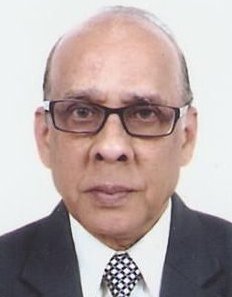TheMoral side of Ramayana (Dr. A. Sreekumar Menon)

Dr. A. Sreekumar Menon
Winner of All India D.M.A- Escort’s awards for two research based Management books , Winner of N.I.P.M Award and I.T.C award of excellence N.I.P.M Award for best papers on Management, Recipient of 5 Fellowships, from University of Kerala , Ministry of Education , Govt of India , U.G.C , Ford Foundation, U.S.A and International Institute of Labour studies , Geneva , Author of 5 Management books of which 2 received All India D.M.A – Escort’s Awards and several articles , Ex-Adviser , Higher Education , Overseas Service. Holder of M.A, PhD degrees, in Psychology and Management and did Post-Doctoral Research in Australia . He has written about almost all Indian festivals and Epics like Ramayana and Bhagavad Gita drawing out moral/ethical/spiritual/human values enshrined in them and interpreting them with originality and has shown how those can be applied in our everyday life for enduring happiness , peace and personal effectiveness and social harmony .
----------------------------------------------------------------------------------------------
Prologue
This is a new interpretation of the monumental epic Ramayana. It is an enquiry into what lessons we have to learn from the story of Ramayana, which would help us to meet the challenges of the present day world and to lead a life of enduring happiness. I have tried to make presentation straight forward, thought provoking and make interesting reading. I have not narrated the story in all its details. as it is not my intention. I have given only aerial view .I spent most of my efforts in unfolding those which are not visible to the readers .As many things are untold than told directly , we find epic Ramayana , other ancient treasures of knowledge and Indian culture and tradition are not seen as making impact on our day today life . It is seen more as symbol for worship than guide to practical living. I don’t claim that I have mined the human values inherent in the epic completely. I have perhaps only scratched the surface .How ever I have given pointer towards further excavations to be undertaken by other scholars and thinkers routed in Indian culture and Philosophy to unravel the unfathomable treasure we have as our ancient thoughts. This work should benefit our present and future generation equally well, so that they become master of rather than victims to circumstances created by consumerism, mass consumption and monstrous material civilization.
1
We all know the story of Ramayana . We know Ramayana just in a narrative way. But the real story is much more than that. It is what comes out in the form of priced human values or values of ethics and morality or the morals of the story or what we human beings can learn from Ramayana. The great sage Valmiki to whom the story was revealed intuitively and the author of the epic Ramayana would have certainly envisaged that the humanity should learn several things for leading perfect lives. I tried to draw out these. The story of Ramayana is highly symbolic, in the sense whatever is told has profound inner meaning and only interpretations or commentary can bring out the inner meaning. The purpose of reading Ramayana should not be based on the belief that we can please Lord Rama and get his blessing. If so, it is nothing but mere superstition and waste of time and effort. The book is not meant just for worship either. The real purpose should be to understand the human /moral/ethical/ social values displayed by Godly characters, emulate them and make them guides to our lives and eschew the evil qualities displayed by Demons in the story, so that we experience divinity, which is deep down within us and about which we are least aware in our fast and mundane life. It is one of the few largest epics ever written with gems of thoughts and very practical ideas, which are more relevant in our modern world than at any time period before. The story depicts incessant struggle between forces of virtues or good and vices or evils represented by characters like Lord Rama, Lord Ravana and so on. Every Asura or Demon who acquires extraordinary powers by doing hard penance, torments the very gods who gave them those powers , overindulge in sense pleasures and perpetrate evils . This is the very characteristic of Demons. It also portrays what goes on in our minds. When strength or power is used for wrong purpose, it becomes weakness and proves to be harmful to one and all. For instance, it is not uncommon to see people who are physically strong to behave rudely with the weak persons, with whom they are ill-disposed .
Forces of virtues are personified as Suras or Gods and those of vices or evils as Asuras or Demons, attributing human form. Demons are infested with lust, vanity and avarice. This way of representation is called Anthropocentrism. It is to make people understand easily. It is also reported in the form of a story .It is interesting to listen to stories. Even small kids like Grandma’ bed time stories. We need not consider Ramayana story as happened in some distant past, although there is no harm in believing that it took place during Dwaparayuga. It depicts what happens in us in our day to day life. Sage Valmiki has narrated the story of perfect human being- Lord Rama and his family as leading ideal human life. Sage Valmiki narrated to Lava and Kusa twins and young children of Lord Srirama, the story of Rama. They retold it to Lord Rama exactly the same way as they heard from Valimiki . It was clear no one else could have had such astounding memory other than those who were born to great parents like Rama and Sita. It is said that Lord Rama himself first heard story of his life faithfully described by Lava and Kusha and he could recognize them as their own sons. They were born to him and Sita, when he left her in the hermit of Agasthya, after taking her with him bydefeating Ravana and returned from Lanka.
The story we know is briefly as follows. There was a king by name Dasaratha who ruled over the kingdom of Hoyasala with justice and good will of the people, the capital of which was Ayodhya .He had three wives Kausalya, Kaikeyi and Sumitra. But he had no sons to succeed him. Hence he was very much upset .As per the advice of sage Vasishta in his court, he performed a ritual called ‘Putrakamesti yaga’ for Gods’ blessings for having children .When the offerings of the worship were shared by his wives, they begot children. The son born to Kousalya was named Rama, that of Kaikeyi named Bharatha , the two children born to Sumitra were named Lakshmana and Satrugna Kousalya was his first wife , Kaikeyi his second and Sumitra as third . They lived in harmony, not being jealous of each other. Compare this with the way a modern wife suspects her husband, when she sees her husband free with other women, married or not. We should not be jealous and think ill of any one. When we entertain feelings of jealousy, we poison our mind .All his wives lived happy and loved all the children as their own. Children also treated all of them as their mothers without discriminating as mothers and step mothers. Do we see this quality in the world today? Is not their behavior worth cultivating?
The concept of praying God for the birth of children implies that human birth is sacred and not simply a biological or mechanical process , as modern man might think .There is belief even today that women should lead a carefree , virtuous and calm life( without tension), when she is in her family way for delivering healthy child endowed with good qualities . Stresses and strains during pre-natal period can affect physical, social, emotional and intellectual development of the child .Many birth defects are due to trauma exp mother experiences during period of pregnancy.
The sacredness of human birth has many practical implications. People should behave with each other as they would like others to behave with them .They should not hate, on the contrary love and be helpful to each other as children of God . They should feel that they are one and the same though their physical bodies are many and gifted by different parents .The origin of life force which is eternal and beyond destruction is residing in all living beings, even in the so called inert objects is one and the same . .By loving each other, all could enjoy happiness and peace of mind.






